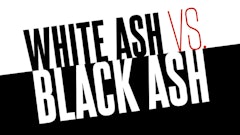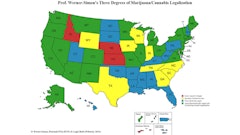
Intellectual property can and should be approached with a strategic focus on where you are, what you are creating and investing in currently, and the direction in which you see your company moving in the future.
This holistic evaluation and planning is not unique to the cannabis industry, but the current regulatory and legal concerns facing this industry are quite unique. Identifying this industry’s specific historical challenges may help you better understand this complicated legal topic and the most effective path forward.
In the June and July 2017 issues of Cannabis Business Times, Dr. Lindsay Moore of KLM Inc. penned a two-part series addressing considerations for cannabis business owners looking to capitalize on the intellectual property (IP) surrounding the culture and branding they create and nurture with their companies. Here, we provide further context for companies navigating this difficult and evolving task.
As IP attorneys, we typically draw a line between the two types of IP protection: (1) Soft IP (e.g., trademarks and copyrights) and (2) Hard IP (patents [utility, design and plant]). Let’s begin with Soft IP.
Federal Trademark Protection
Current U.S. law defines a trademark as a word, phrase, symbol or design that distinguishes the source of goods of one company from another. A service mark is a trademark that applies to services instead of goods/tangible products. For example, “NIKE” is a trademark on athletic goods and apparel, while “McDonald’s” is a service mark on food services. Both companies have a range of other trademarks that consumers readily recognize, including phrases (“Just Do It” and “I’m Lovin’ It”) and logos (the NIKE Swoosh and the McDonald’s Golden Arches).
Obtaining a federal trademark registration (with an attorney’s help) may cost between $2,000 and $5,000. Unlike patents and copyrights (which expire), a trademark could be enforceable indefinitely so long as it is properly and continuously used in commerce. Put simply, federal trademark registration often provides the cheapest, broadest and most long-term protection for brand holders who may not be able to protect their IP in other ways. The cost and scope are intentional because to federally register a trademark, a company must demonstrate it has used and is using the mark in commerce with the goods and services for which it is claiming protection. In essence, a trademark is the IP closest to the brand, and, if registered, provides numerous advantages. Two of the most noteworthy advantages are:
(1) Nationwide protection, which includes federal jurisdiction for enforcement, national notice, customs protection, presumption of validity, presumption of ownership and the right to use the ® symbol; and
(2) Indefinite protection for brands (if the brand is continuously used in connection with the goods and/or services of the brand owner), which is unique as compared to other IP rights.
History Suggests …
But, the U.S. Patent and Trademark Office (USPTO) has been historically inconsistent with its acceptance, prosecution and registration of federal trademark applications in the cannabis space, which provides particular challenges.
For example, in 2010, the USPTO invited applicants to apply for federal trademark registrations on cannabis goods and services. For applicants to do so, the USPTO created a new entry in its “Acceptable Identification of Goods and Services Manual” called Class 5: “Processed plant matter for medicinal purposes, namely medical marijuana.”
Countless federal trademark applications for cannabis products poured in; however, within a matter of months, the USPTO announced it had made a “mistake” and repealed Class 5. In that regard, the USPTO’s rules on federal trademark applications for cannabis products, as disappointing as they may be, are not complicated.
Today’s Reality
Since repealing Class 5, the USPTO has become increasingly clear that the lack of any lawful uses of the applied-for marks in commerce is the basis for denying any cannabis-related federal trademarks involving the cannabis plant and many contributory, often federally illegal, goods and services. And the legal basis for providing federal trademark protection (the Lanham Act) only considers cannabis’s legality at the federal level. So the only thing preventing federally protected cannabis trademarks is federal cannabis prohibition under the Controlled Substances Act (CSA). Put simply, the Lanham Act asks whether the subject matter to be protected is illegal under federal law and, for cannabis, the unequivocal answer is “yes.”
This prohibition has been enforced by both the USPTO and the administrative board that reviews trademark refusals: the Trademark Trial and Appeal Board (TTAB). In 2016, the TTAB reiterated this longstanding prohibition in the case entitled In re Brown by noting that the USPTO and TTAB have “consistently held that, to qualify for a federal service mark [or trademark] registration, the use of a mark in commerce must be ‘lawful.’” This case affirmed the refusal of a mark for the sale of cannabis-based herbs based on lack of lawful use in commerce.
What Are Your Options?
So, what are cannabis businesses to do? Give up? Wait for U.S. Attorney General Jeff Sessions to overturn the current cannabis scheduling? No—you must evaluate the nature of your goods and services, the direction and scope of your brand and products, and get creative.
For example, knowing the mandatory prohibition on illegal activity for federal trademark protection of the Lanham Act and the CSA, consider how close you can and want to go without stepping into prohibited activity under the CSA. Filing for federal trademarks on cannabis products themselves is clearly too far at this point. But, if you’re in the business of cannabis-related goods and services, you and the USPTO have got a harder call.
Let’s break that down. On one end, there are products and services the USPTO, while examining your application, may label as “paraphernalia,” for which the USPTO has also refused trademarks and service marks as they arguably fall within the definition of “illegal drug paraphernalia” under the CSA.
(The TTAB in 2016 in a case entitled In re JJ206, LLC, dba JuJu Joints refused to register the marks “POWERED BY JUJU” and “JUJU JOINTS” on the principal register, which were related to cannabis vaporizing devices, because the marks constituted illegal drug paraphernalia under the CSA.)
On the other end, however, federal trademarks and service marks have been granted to ancillary products and services (e.g., cannabis apparel companies, informational services, cannabis networking organizations; all companies unrelated to the direct production, sale and/or use of cannabis). Considering recent precedent from the U.S. Supreme Court, this ground for federal trademark registration is looking more fruitful all the time.
For instance, certain trademarks have historically been denied under Section 2(a) of the Lanham Act commonly known as the “disparagement clause,” which prohibits the registration of a mark that “[c]onsists of or comprises immoral, deceptive, or scandalous matter; or matter which may disparage or falsely suggest a connection with persons, living or dead, institutions, beliefs, or national symbols, or bring them into contempt, or disrepute.” But recently in Matal v. Tam, the Supreme Court held that Section 2(a) of the Lanham Act violates the Free Speech Clause of the First Amendment, claiming “[i]t offends a bedrock First Amendment principle: Speech may not be banned on the ground that it expresses ideas that offend.” As such, it seems the USPTO can no longer rely on the disparagement clause to reject cannabis-related trademarks.
What to Expect When You’re Expecting a Trademark
As encouraging as federal trademark protection for these ancillary goods and services may be, applicants should be prepared to argue against USPTO rejections by being able to show how the applied-for cannabis-related mark does not violate the CSA.
Alternatively, cannabis business owners are increasingly looking to trademark protections afforded at the state level, because many states that have legalized cannabis in some form have begun exploring and instituting statutory bases for registering cannabis-related trademarks and service marks under state law. Thus, state trademark rights may provide some of the most fruitful grounds for cannabis trademark rights currently, especially for those brands that involve the plant directly.
Although complicated, this branding and protection is critical, as the cannabis industry relies on brand names to promote new strains and products, as well as to help consumers distinguish between strain characteristics. For example, if consumers are looking to buy a strain with one or more particular medicinal effects, it is important for consumers to know exactly what they are purchasing (e.g., phenotype, potency, dosage, delivery form), depending on what ailments are being treated and/or the effects sought.
Because a foundational purpose of trademark law is to ensure consumers can identify the sources of goods and services so they can rely on the quality they expect from those goods and services, navigating the fine line of trademark protection at both federal and state levels is an exercise worth undertaking at almost every juncture for cannabis businesses.
On the other end of the complicated soft IP spectrum is federal copyright law, which does not exclude cannabis companies from obtaining federal copyright protection.
Federal Copyright Protection
The Copyright Act of 1976 does not contain the same express prohibition as the Lanham Act (re: violating federal law), and because copyright applications are reviewed and granted by the U.S. Copyright Office—a separate entity from the USPTO that has not, to date, prohibited registering cannabis-related copyrights—the concerns surrounding federal trademarks do not exist for copyright protection.
This means federal copyright protection currently seems to be on the table for affording companies the options to protect logos and visual designs associated with their cannabis brand under federal law.
Copyrights are inexpensive to apply for and obtain compared to patents (and even trademarks/service marks). For example, as a rough estimate, a brand owner (with an attorney’s help) may be able to obtain a federal copyright registration for less than $1,000, a fraction of the cost of registering a federal trademark. Additionally, a granted patent can cost more than $30,000 depending on the amount of USPTO resistance you encounter and the technology involved. Thus, cannabis brand owners should seriously consider protecting their brand logos and other visual designs in connection with materials such as marketing collateral, T-shirts and accessories.
Now that we’ve covered the basics of Soft IP, let’s discuss Hard IP, specifically patent protection for cannabis and cannabis-related inventions.
Federal Patent Protection
The USPTO grants patents on new and useful inventions or improvements; patents give the patent owner the right to exclude others from making, using and selling the invention in the U.S. The USPTO is not deterred from granting patents on cannabis products, despite cannabis’s current classification as a Schedule I drug.
In this regard, courts (such as the Circuit Court for the District of Massachusetts in 1817 in the case entitled Lowell v. Lewis) have historically found that an invention is not useful, and is therefore ineligible for patent protection if it is “frivolous or injurious to the well-being, good policy, or sound morals of society.” As a result, several patents have been invalidated based on being immoral or offensive, such as those related to gambling or lottery.
However, the courts and the USPTO have retreated from this concept of moral utility in recent years, which has paved the way for patenting cannabis and cannabis-related inventions. The USPTO’s prominent reference source when examining patent applications, the “Manual of Patent Examining Procedure,” now states that “[a] rejection under 35 U.S.C. 101 for lack of utility should not be based on grounds that the invention is frivolous, fraudulent or against public policy.” Thus, it seems highly unlikely that a cannabis-related patent would be invalidated or that a cannabis- related patent application would be rejected under the moral utility doctrine.
There seems to be no limit to the kinds of cannabis patents the USPTO will examine and issue, and cannabis businesses should keep patents in the forefront of their intellectual property strategies. Many cannabis companies already have done so. The USPTO has granted hundreds of cannabis patents to date, including at least 300 granted patents and more than 500 published applications involving cannabis-related inventions. These numbers (which continue to grow daily) are conservative estimates based on searches for patents and patent applications containing the term “cannabis” or “cannabinoid” in the title. These patents cover a range of cannabis-related inventions, including methods of medical treatment with cannabinoids (e.g., U.S. Patent No. 9,717,683), cannabis-infused edible products (e.g., U.S. Patent No. 8,906,429), THC extraction techniques (e.g., U.S. Patent No. 8,895,078), cannabis consumption devices (e.g., U.S. Patent No. 9,408,986), and methods of growing cannabis plants (e.g., U.S. Patent No. 9,642,317).
Furthermore, the cannabis plant itself is also patentable via utility and plant patents. The USPTO issued the first plant patent Dec. 20, 2016, PP27,475, entitled “Cannabis plant named ‘Ecuadorian Sativa.’” Thus, an important consideration for cannabis businesses is that while the vast majority of these applied-for and granted patents have been utility patents, plant and design patents are also increasingly being applied for and issued.
Finding Balance
While the foundational purpose of patents is to encourage innovation, the scope and subject matter of some of these granted patents has caused many in the industry to become concerned over their potential to stifle the cannabis market. Many are keeping their eyes on a family of patents owned by Biotech Institute LLC of Westlake, Calif., entitled “Breeding, Production, Processing, and Use of Specialty Cannabis” (collectively, the “Biotech cannabis patents”). Currently, this family contains three granted U.S. patents, two pending U.S. patent applications and foreign patents that have been filed in Mexico, Europe and Canada.
The Biotech cannabis patents provide, according to the abstract, “compositions and methods for the breeding, production, processing and use of specialty cannabis,” and are, compared to most, incredibly expansive. Specifically, the as-filed specification for the main patent application in this family contained more than 250 pages and included 43 examples directed to a host of potential inventions, including:
- Chemical analysis of cannabinoids and terpenes of the plants described in the specification,
- Parental classes of cannabis varieties,
- Breeding programs,
- Cannabis plants that produce both THC and CBD or CBD alone,
- Feedback-based cultivation systems, and
- Use of multiplexed cannabis mixtures to treat brachial plexus avulsion, arthritis, motion sickness, seizures, neuropathic pain, depression, irritable bowel syndrome, pain from cancer, psychosis- related diseases (e.g., schizophrenia), as well as to aid in weight loss and improve cholesterol levels.
Although the application contains extensive tables showing cannabinoid and terpene profiles of the cannabis varieties described in the specification, as well as actual data from volunteer trials using the plants, many of the examples are merely theoretical. Given the seemingly endless number of embodiments disclosed in the specification, however, Biotech Institute will almost certainly continue to file patent applications to keep this family pending before the USPTO.
Patents Granted
Turning to the patents themselves, the first patent in Biotech’s family was granted as U.S. Patent No. 9,095,554 (“the ’554 patent”) Aug. 4, 2015.
Claim 1 of the ’554 patent reads:
1. A hybrid cannabis plant, or an asexual clone of said hybrid cannabis plant, or a plant part, tissue, or cell thereof, which produces a female inflorescence, said inflorescence comprising:
a) a BT/BD genotype;
b) a terpene profile in which myrcene is not the dominant terpene;
c) a terpene oil content greater than about 1.0% by weight; and
d) a CBD content greater than 3%;
wherein the terpene profile is defined as terpinolene, alpha-phellandrene, beta-ocimene, careen, limonene, gamma-terpinene, alpha-pinene, alpha- terpinene, beta-pinene, fenchol, camphene, alpha-terpineol, alpha-humulene, beta-caryophyllene, linalool, cary-oxide, and myrcene, and wherein the terpene oil content is determined by the additive content of the terpenes in the terpene profile; and wherein the terpene contents and CBD content are measured by gas chromatography-flame ionization detection (GC-FID) and calculated based on dry weight of the inflorescence; wherein a representative sample of seed producing said plants has been deposited under NCIMB Nos. 42246, 42247, 42248, 42249, 42250, and 42254.
At first glance, the independent claim of the ’554 patent seems limited in that it requires the plant to contain a certain percentage of CBD, a terpene profile of more than 15 specific terpenes (but where myrcene is not the dominant terpene) as well as specific deposit numbers of seeds that are representative of the strains described by claim 1.
Despite these limitations, commentators have speculated that anywhere between 50 to 70 percent of all cannabis plants currently on the market may infringe Biotech Institute’s patents, which could pose a serious threat to growers. Unlike plant patents, which are often narrower and cover a well-defined new plant variety, utility patents directed to plants can be broader and have the potential to cover a range of varieties. Like the ’554 patent, the claims of the other granted patents in the Biotech family (U.S. Patent Nos. 9,370,164 and 9,642,317) are directed to a cannabis plant with particular cannabinoid and terpene characteristics.
Enforcing Your Rights
The potentially overly broad scope of the Biotech cannabis patents highlights a couple issues with prosecuting and challenging patents on cannabis plants. For example, there seems to be a lack of published information (USPTO examiners call this published information “prior art”) that describes chemotypes of strains that were previously available and/or are currently available on the market. Without this information, patent examiners are unable to accurately determine whether a claimed plant with a particular chemotype is novel and non-obvious.
The lack of public information on varieties in the market may pose similar challenges for third parties seeking to challenge the validity of patents covering cannabis plants through the USPTO’s various post-grant proceedings. A meaningful challenge (particularly for an inter partes review proceeding) would require information on the plants that were available at the time the patent application was filed—i.e., prior art. Although none of the Biotech cannabis patents have yet been subjected to a validity challenge before the USPTO, it seems inevitable for those in the industry that become more aware of (and concerned with) the breadth of the portfolio (assuming relevant prior art and a cost benefit of undertaking the process).
In direct response to these issues, and in response to Biotech Institute’s patents, groups such as the Open Cannabis Project (OCP) are working to catalog and publish the chemotype data of cannabis plants currently in the public domain. OCP’s mission, in part, is to prevent broad utility patent protection for plants. Having such a database will help ensure that patents on cannabis plants are properly limited.
The Big Takeaway
For cannabis businesses seeking IP protection, whether by federal trademark, copyright or patent protection, the advice at this point is simple: Think about protecting your IP rights and work hard to do the enforcement early, often and aggressively. In such a rapidly emerging market, the potential for IP rights surrounding the Green Rush presents a seemingly infinite forecast of rewards for those adventurous and informed enough to navigate it intelligently.

























